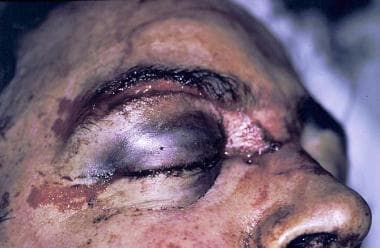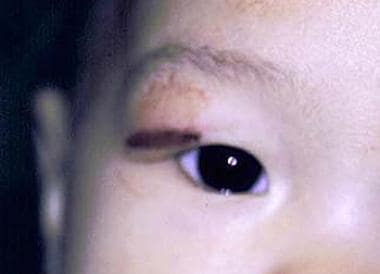Practice Essentials
In all patients with eyelid injuries, exclude underlying globe injury, canalicular laceration, and foreign body.
During surgical repair of lid lacerations, ensure that no knots or suture material can damage the cornea.
Background
Numerous mechanisms of blunt and penetrating facial trauma may result in eyelid lacerations. Even seemingly innocuous blunt objects in the workplace can cause eyelid lacerations in experienced workers. [1]
 Penetrating lid trauma with extensive periorbital ecchymosis. A ringlike projectile was ejected from a pipe fitting under high pressure. The patient also experienced choroidal rupture and traumatic optic neuropathy.
Penetrating lid trauma with extensive periorbital ecchymosis. A ringlike projectile was ejected from a pipe fitting under high pressure. The patient also experienced choroidal rupture and traumatic optic neuropathy.
Eyelid lacerations may (1) involve the lid margin, requiring a meticulous suture technique; (2) be extramarginal; or (3) cause tissue loss. [2]
 Extramarginal upper lid laceration from blunt trauma in an infant. Such lacerations tend to follow relaxed skin tension lines.
Extramarginal upper lid laceration from blunt trauma in an infant. Such lacerations tend to follow relaxed skin tension lines.
Proper management includes the following:
-
Excluding any accompanying injury to the globe
-
Protecting the cornea and maintaining proper lid dynamics
-
Excluding a foreign body
-
Minimizing the risk for infection
-
Optimizing cosmesis
Epidemiology
Age
Eyelid lacerations are most frequently encountered in young men, but can occur at any age and have even been described in newborns after cesarean delivery. [3]
Location
In a study from Iran, the right upper lid was the most frequently involved site of injury. [4]
Prognosis
The visual prognosis for lid lacerations is usually excellent unless there is accompanying globe rupture.
With proper reconstruction of lid lacerations, the cosmetic result is usually quite good. Lid notching, cutaneous scars, and cicatricial ectropion may require revision surgery.
-
Extramarginal upper lid laceration from blunt trauma in an infant. Such lacerations tend to follow relaxed skin tension lines.
-
Penetrating lid trauma with extensive periorbital ecchymosis. A ringlike projectile was ejected from a pipe fitting under high pressure. The patient also experienced choroidal rupture and traumatic optic neuropathy.
-
Preoperative. This child had a dog bite injury with a double lower lid margin laceration, dehiscence of the lateral canthal tendon, and disruption of the inferior canaliculus.
-
Postoperative. The inferior canaliculus was repaired with bicanalicular stenting. Lateral canthus reattachment and repair of lid margin lacerations was performed.

